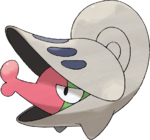Shelmet

| |||
| The Snail Pokémon | |||
| #616 - Shelmet | |||
| Evolve | Accelgor | ||
| Debut | Pokémon: Black Version Pokémon: White Version | ||
| Species Info | |||
| Type | |||
| Height | 0.4 m (1'04") | ||
| Weight | 7.7 kg (17 lbs.) | ||
| Color | Red | ||
| Gender Ratio | 1♂ : 1♀ | ||
| Ability | Hydration / Shell Armor | ||
| Hidden Ability | Overcoat | ||
| Egg Group | Bug | ||
| Icon | Sprite | ||
| File:I616.gif | File:616sprite.png | ||
| Footprint | |||
| 30px | |||
| Base Statistics | |||
| Hit Points | 50 | Speed | 25 |
| Attack | 40 | Sp. Attack | 40 |
| Defense | 85 | Sp. Defense | 65 |
| Training Info | |||
| Catch Rate | 200 | Hatch Steps | 3,840 |
| Base Exp. | 061 | Effort Points | Def |
| Happiness | 70 | ||
| To Lv.100 | Normal | ||
| Kanto # | Johto # | Hoenn # | Sinnoh # |
|---|---|---|---|
| < 616 > | |||
| Unova # | Johto (IV) # | ||
| < 122 > |
Shelmet is a shelled insect Pokémon that was introduced in the fifth generation games. Its evolved form is Accelgor, and it shares a mysterious connection with Karrablast.
Information[edit]
Shelmet has a thick shell and protects itself when attacked by closing the lid of its shell. It can spit out a sticky, poisonous liquid as well. Shelmet also shares a mysterious connection with Karrablast, and for that reason Karrablast are constantly pursuing Shelmet. Shelmet and Karrablast both evolve when exposed to a mysterious electrical energy within the same area. This causes Shelmet to lose its shell and evolve into Accelgor while at the same time Karrablast gains the shell to evolve into Escavalier. In-game, both of these evolutions are triggered by trading a Shelmet for a Karrablast (with the electric energy presumably being part of the trade).
Appearances[edit]
Mainstream Games[edit]
In Pokémon: Black and White Versions, Shelmet could be found somewhat commonly in the marshy areas of Route 8, Irricus City and the Moor of Irricus in all seasons save for winter.
Trivia[edit]
- Its name is a simple combination of "shell" and "helmet", which both emphasize its defensive shell.
- Pages with broken file links
- Creatures
- Pokémon
- Bug Type Pokémon
- Red Colored Pokémon
- Hydration Ability Pokémon
- Shell Armor Ability Pokémon
- Overcoat Ability Pokémon
- Bug Egg Group Pokémon
- Pokémon that yield Def Points
- Pokémon with catch points
- Pokémon with hatching steps
- Pokémon with exp base
- Pokémon with happiness base
- Pokémon with Lv 100